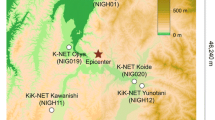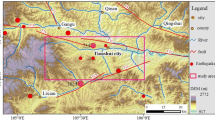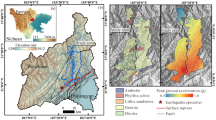Abstract
The 2016 Kumamoto earthquake first occurred on April 14, 2016 with magnitude 6.5 in Kumamoto, Japan as a foreshock. Subsequently, after 28 h, an even larger earthquake occurred with magnitude 7.3 as the main shock on April 16, 2016. These earthquakes were caused by two active faults: the Futagawa and Hinagu faults. This paper proposes a landslide susceptibility calculation method that considers the geomaterial strength reduction from peak to residual state and ground motion directivity. Although there is a lack of information regarding the strength parameters of geomaterials in the slopes, a parametric analysis with various strength parameters of friction angle and cohesion was carried out. To simulate the actual landslides triggered by the 2016 Kumamoto earthquake, the best combination of friction angle and cohesion in each lithology was optimized by a proposed weighted prediction rate. Based on the calculated permanent seismic displacement, a landslide susceptibility map was produced to show the degree of susceptibility over a wide area comprising 100 km2. The proposed regional landslide susceptibility map will be valuable for estimating the locations of possible slope failures and the extent of damage, as well as for planning field reconnaissance and preventing secondary disasters immediately after earthquakes.




















Similar content being viewed by others
References
Arias A (1970) A measure of earthquake intensity. In: Hansen RJ (ed) Seismic design for nuclear power plants. MIT Press, Cambridge, MA, pp 438–489
Bray JD, Travasarou T (2007) Simplified procedure for estimating earthquake-induced deviatoric slope displacements. J Geotech Geoenviron 133(4):381–392
Cabinet Office (2018) Damage situation related to earthquake with seismic source in Kumamoto district, Kumamoto Prefecture, 2016, reported on 2018.4.13 (in Japanese)
California Geological Survey (2004) Recommended criteria for delineating seismic hazard zones in California. Calif Geol Surv Spec Publ, 118 (12 pp.)
California Geological Survey (2012) Seismic hazard zone report for the lick observatory 7.5-minutes quadrangle, Santa Clara country, California. Calif Geol Surv, Seismic Hazard Zone Report 110, Section 2
Chen CW, Chen H, Wei LW, Lin GW, Iida T, Yamada R (2017) Evaluating the susceptibility of landslide landforms in Japan using slope stability analysis: a case study of the 2016 Kumamoto earthquake. Landslides 14(5):1793–1801. https://doi.org/10.1007/s10346-017-0872-1
Chiaro G, Umar M, Kiyota T, Christopher C (2018) The Takanodai landslide, Kumamoto, Japan: insights from post-earthquake field observations, laboratory tests, and numerical analysis. Geotech Earthq Eng Soil Dyn, GSP 293:98–111
Chiba T, Kaneta S, Suzuki Y (2008) Red relief image map: new visualization method for three dimensional data. Int Arch Photogramm Remote Sens Spat Inf Sci 37:1071–1076
Chousianitis K, Gaudio VD, Kalogeras I, Ganas A (2014) Predictive model of Arias intensity and Newmark displacement for regional scale evaluation of earthquake-induced landslide hazard in Greece. Soil Dyn Earthq Eng 65:11–29. https://doi.org/10.1016/j.soildyn.2014.05.009
Dreyfus D, Rathje EM, Jibson RW (2013) The influence of different simplified sliding-block models and input parameters on regional predictions of seismic landslides triggered by the Northridge earthquake. Eng Geol 163:41–54
Forest Agency of the Ministry of Agriculture, Forestry, and Fisheries (2016) Report of aviation laser measurement work in the forest area. http://www.rinya.maff.go.jp/j/kouhou/jisin/rezakohyo2.html. Accessed 18 Jan. 2019 (in Japanese)
Fukunaga E, Shimizu O (2017) Soil layer structure and soil strength in the vicinity of the slip surface in the collapsed area of the Aso central volcano induced by the 2016 Kumamoto earthquake. Proc Jpn Soc Eros Control Eng, pp 676–678
Geological Survey of Japan (GSJ) (2019) Geological Map of Volcano, Other Maps, https://www.gsj.jp/Map/EN/ volcano. html, Accessed 30 Jan. 2019
Geospatial Information Authority of Japan (2016) Response of geographic department to the 2016 Kumamoto earthquake—geographic department disaster countermeasures group. J Geospatial Inform Authority Jpn 128:197–199
Hsieh SY, Lee CT (2011) Empirical estimation of the Newmark displacement from the Arias intensity and critical acceleration. Eng Geol 122(1–2):34–42
Inagaki H (2017) Relationship between slope failure and the active fault based on Kumamoto earthquake in 2016 and following heavy rainfall induced disaster. J Japan Soc Eng Geol 58(3):188–196
Japan Society of Engineering Geology (JSEG) (2017) Report of the 2016 Kumamoto, Oita earthquake disaster research mission (in Japanese)
Japanese Geotechnical Society (JGS) (2016) Geotechnical disaster report on the 2016 Kumamoto earthquake (in Japanese)
Japanese Society of Civil Engineers (JSCE) (2017) Report on the damage surveys and investigations following the 2016 Kumamoto earthquake (in Japanese)
Jibson RW (2007) Regression models for estimating coseismic landslide displacement. Eng Geol 91(2–4):209–218
Jibson RW, Michael JA (2009) Maps showing seismic landslide hazards in Anchorage, Alaska. US Geol Surv Sci Investig Map 3077 (11)
Jibson RW, Harp EL, Michael JA (2000) A method for producing digital probabilistic seismic landslide hazard maps. Eng Geol 58(3–4):271–289
Kanai T, Asai K, Sasaki Y, Norimizu S (2016) Evaluation of slope stability based on the soil strength probe. Proc Jpn Soc Eng Geol, 169–170
Kiyota T, Ikeda T, Konagai K, Shiga M (2017) Geotechnical damage caused by the 2016 Kumamoto earthquake, Japan. Int J Geoengin Case Hist 4(2):78–95. https://doi.org/10.4417/IJGCH-04-02-01
Kramer SL (1996) Geotechnical earthquake engineering. Prentice Hall, Upper Saddle River, NJ, p 435
Kurokawa U (2018) Hillside collapse induced by the 2016 Kumamoto earthquake. Water Sci 61(6):18–33 (in Japanese)
Matasovic E, Kavazanjian E Jr, Giroud JP (1998) Newmark seismic deformation analysis for geosynthetic covers. Geosynth Int 5(1–2):237–264
McCrink TP (2001) Mapping earthquake-induced landslide hazards in Santa Cruz County. In: Ferriz, H, Anderson, R (ed) Engineering geology practice in northern California. Calif Geol Surv Bull 210/Assoc Eng Geol Spec Publ 12, pp 77–94
Miles SB, Ho CL (1999) Rigorous landslide hazard zonation using Newmark’s method and stochastic ground motion simulation. Soil Dyn Earthq Eng 18(4):305–323
Mukunoki T, Kasama K, Murakami S, Ikemi H, Ishikura R, Fujikawa T, Yasufuku N (2016) Reconnaissance report on geotechnical damage caused by an earthquake with JMA seismic intensity 7 twice in 28 h, Kumamoto, Japan. Soils Found 56(6):947–964. https://doi.org/10.1016/j.sandf.2016.11.001
National Research Institute for Earth Science and Disaster Resilience (NIED) (1996) Strong-motion seismograph networks (K-NET, KiK-NET). http://www.kyoshin.bosai.go.jp/kyoshin/. Accessed 18 Jan. 2019 (in Japanese)
National Research Institute for Earth Science and Disaster Resilience (NIED) (2016) Landslide distribution map by the 2016 Kumamoto earthquake. http://www.bosai.go.jp/mizu/dosha.html. Accessed 18 Jan. 2019 (in Japanese)
Newmark NM (1965) Effects of earthquakes on dams and embankment. Geotech 15(2):139–160
Ono K, Watanabe K (1985) Geological map of Aso volcano. Geological Map of Volcanoes 4 scale 1:50,000
Railway Technical Research Institute (RTRI) (2007) Design standards for railway structures and commentary (Earth structures). Railw Tech Res Inst, Maruzen (in Japanese)
Railway Technical Research Institute (RTRI) (2012) Design standards for railway structures and commentary (Soil retaining structures). Railw Tech Res Inst, Maruzen (in Japanese)
Rathje EM, Saygili G (2009) Probabilistic assessment of earthquake-induced sliding displacements of natural slopes. Bull NZ Soc Earthq Eng 42(1):18–27
Romeo R (2000) Seismically induced landslide displacement: a predictive model. Eng Geol 58(3–4):337–351
Roy R, Ghosh D, Bhattacharya G (2016) Influence of strong motion characteristics on permanent displacement of slopes. Landslides 13(2):279–292. https://doi.org/10.1007/s10346-015-0568-3
Saade A, Abou-Jaude G, Wartman J (2016) Regional-scale co-seismic landslide assessment using limit equilibrium analysis. Eng Geol 204(8):53–64
Saito H, Uchiyama S, Hayakawa YS, Obanawa H (2018) Landslides triggered by an earthquake and heavy rainfalls at Aso volcano, Japan, detected by UAS and SfM-MVS photogrammetry. Prog Earth Planet Sci 5:15. https://doi.org/10.1186/s40645-018-0169-6
Shinoda M, Miyata Y (2017) Regional landslide susceptibility following the mid Niigata prefecture earthquake in 2004 with Newmark’s sliding block analysis. Landslides 14(6):1887–1899. https://doi.org/10.1007/s10346-017-0833-8
Song K, Wang F, Dai Z, Iio A, Osaka O, Sakata S (2017) Geological characteristics of landslides triggered by the 2016 Kumamoto earthquake in Mt. Aso volcano, Japan. Bull Eng Geol Environ 78(1):167–176. https://doi.org/10.1007/s10064-017-1097-1
Wasowski J, Keefer DK, Lee CT (2011) Toward the next generation of research on earthquake-induced landslides: current issues and future challenges. Eng Geol 122(1–2):1–8. https://doi.org/10.1016/j.enggeo.2011.06.001
Wieczorek GF, Wilson RC, Harp EL (1985) Map showing slope stability during earthquakes in San Mateo County, California, US Geol Surv Misc Geol Investig Map 1–1257E, scale 1:62,500
Wilson RC, Keefer DK (1983) Dynamic analysis of a slope failure from the 6 August 1979 Coyote Lake, California, earthquake. Seismol Soc Am Bull 73:863–877
Xu C, Ma S, Tan Z, Xie C, Toda S, Huang X (2017) Landslides triggered by the 2016 Mj 7.3 Kumamoto, Japan, earthquake. Landslides 15:551–564. https://doi.org/10.1007/s10346-017-0929-1
Acknowledgements
We would like to thank the Forestry Agency and the Ministry of Agriculture, Forestry and Fisheries for providing the data used in this study. We would also like to thank the Geospatial Information Authority (GIA); the Ministry of Land, Infrastructure, Transport, and Tourism; and the National Research Institute for Earth Science and Disaster Prevention (NIED) of Japan for giving us access to their data. Some of the figures were made using the Generic Mapping Tools software package. This work was supported by the Japan Society for the Promotion of Science (JSPS) Grants-in-Aid for Scientific Research (KAKENHI) program (grant no. JP16K01343).
Author information
Authors and Affiliations
Corresponding author
Rights and permissions
About this article
Cite this article
Shinoda, M., Miyata, Y., Kurokawa, U. et al. Regional landslide susceptibility following the 2016 Kumamoto earthquake using back-calculated geomaterial strength parameters. Landslides 16, 1497–1516 (2019). https://doi.org/10.1007/s10346-019-01171-1
Received:
Accepted:
Published:
Issue Date:
DOI: https://doi.org/10.1007/s10346-019-01171-1




